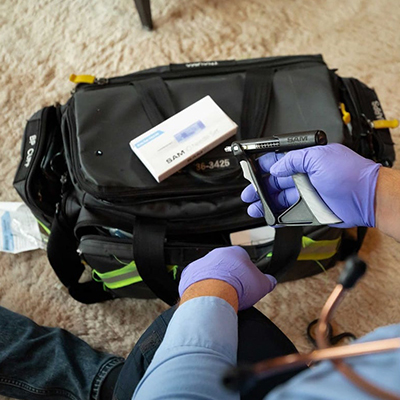Intraosseous (IO) access requires specially designed needles to penetrate through the surface into the medullary cavity, which is the space that contains bone marrow, in order to deliver fluid or medication or to collect a blood sample. It is employed in emergency situations where normal vascular access is not feasible or would delay necessary treatment.
First developed in 1922, IO access was used extensively during World War 2 to treat severely wounded soldiers in triage that otherwise would have not survived the journey to a field hospital. IO access, however, was not seen as a standard treatment in civilian hospitals until the 1980s, and even then it was typically reserved for pediatric patients. However, advances in IO technology made IO access easier and reduced the risk of infection, and as a result, IO access began to see more widespread use in adult patients.
Now IO access is made easier and faster with the FDA-approved SAM IO Intraosseous Driver from SAM Medical. Continue reading to learn about its use, advantages, and helpful accessories.
When to Use the SAM IO Intraosseous Access System
IO access is used in emergency situations such as shock, cardiac arrest, severe dehydration, or gastrointestinal hemorrhage. IO access can be the quickest and best way to deliver necessary fluids and medications in these scenarios. In fact, IO access can double the success of the peripheral IV route in patients who have experienced critical trauma and do not have adequate blood pressure.
Other situations for IO access are for administering contrast or drawing blood when Intravenous (IV) access is not possible or would consume too much time. Burns, fluid retention, and damage from IV drug use can all play a factor in delaying IV access and necessitate IO access.
Pediatric IO Access
IO administration is a widely used option when delivering anesthetic drugs to pediatric patients. Even though insertion of the IO needle is very painful, the IO needle insertion procedure is typically performed on pediatric patients without anesthesia. Instead, distraction and immobilization of the child is preferred.
While there is a risk of potential complications from IO access, studies have shown that the overall complication rate associated with IO access to be slightly less than 1%. Potential complications can include bone fracture from the IO device, catheter misplacement, bone and tissue damage from the needle breaking off in the bone, and osteomyelitis (bone infection).
Most of these complications can be prevented with the use of proper training and technique, and sterile equipment. Careful and frequent observation of the IO site is also essential to reduce the risk of infection and other serious issues such as compartment syndrome.
Advantages of the SAM IO Driver
The SAM IO intraosseous access system is manually operated, giving the user more control over catheter placement.
Simply place the SAM IO Driver at the application site and pull the trigger assembly while gently guiding the SAM IO needle into position. Repeated trigger actuation starts rotational spin of the needle assembly. Add gentle downward pressure to achieve controlled IO placement. Once the needle is in place, the stylet is removed to reveal a standard Luer-Lock for extension set connection. After the extension set is connected, the user can begin flushing and treatment.
The SAM IO Driver’s durable polycarbonate material construction has been certified under MILSTD 810G testing, which is a United States Military Standard for testing the operational limits of a piece of equipment. Even though it is meant for military equipment, it can be used as a testing standard for civilian goods, as well.
MILSTD 810G Tests
The series of tests not only tests the durability of equipment or medical devices but also its ability to operate under harsh conditions. There are drop tests, or “shock” tests, that test a piece of equipment’s resilience when dropped onto a hard surface.
There are also high and low temperature tests that examine a piece of equipments ability to operate in extreme heat or cold, including temperatures that may exceed the equipment’s limits for functionality.
Another important test is liquid, dust, sand, and particle incursion. These tests determine a piece of equipment’s resistance to these factors, and how well (or if) it functions afterwards. It’s important to realize that water-resistant doesn’t necessarily mean watertight – it simply means that the equipment can still function properly even when water has entered.
With a length of only 5.5 inches and weighing only 2.5 ounces, the SAM IO Driver is easy to handle and not cumbersome to operate. It’s designed to be intuitive for current IO users, featuring color coded needles and depth indicators which match industry standards. The entire SAM IO Intraosseous Access System includes the IO700-EN Intraosseous Access Driver, 3 SAM IO needles in 15 mm, 25 mm, and 45 mm sizes, SAM IO Stabilizer, and SAM IO Adapter. The SAM IO Stabilizer features a cylindrical design to protect the catheter from dislodgment, and the SAM IO Adaptor attaches to the SAM IO Driver so that the device can accommodate alternative IO needles.
SAM IO Driver Accessories
A smart addition to your SAM IO Intraosseous Access System is the SAM IO Field Storage Case. This soft-sided storage case easily houses all of the components of the SAM IO System and protects it from damage when out in the field. It can hold the SAM IO Driver, multiple needle packs, the needle adaptor, and stabilizer. Everything is secured in place with velcro straps and a mesh pocket allows quick identification of the case’s contents.
The durable weather-resistant nylon material can withstand a multitude of harsh field conditions, making the SAM IO Field Storage Case ideal for first responders and Emergency Medical Services (EMS) personnel.
In order to familiarize healthcare providers with the SAM IO Intraosseous Access System, SAM Medical also offers a training kit so that IO delivery can be practiced in a controlled setting. The SAM IO Training Kit includes non-sterile training versions of everything that is included in the functional SAM IO Intraosseous Access System. The training kit is available in four versions depending on which bone is to be used for training. You can select a training kit with a proximal humerus sawbone, a proximal tibia sawbone, a distal tibia sawbone, or all three.
Use of the SAM IO Driver
The SAM IO is designed for effective IO placement in both adult and pediatric patients. When determining the anatomical site and needle length for intraosseous access, patient age and physiology should be considered per local safety protocol or standards, and on a case by case basis based on clinical judgment.
Common insertion sites include the proximal humerus, the proximal tibia, the distal tibia, or the distal femur (for pediatric patients). The SAM IO Driver is not designed or intended for sternal use. Use of an IO site should be limited to 24 hours, otherwise the risk for bone infection increases dramatically. The IO site should be removed as soon as IV access has been made.
The SAM IO Driver is not appropriate for all situations. If there is a fracture in the targeted bone, a previous major orthopedic procedure at the site, or an infection, another site should be targeted for IO placement. Do not attempt IO placement if there is excessive tissue or absence of anatomic landmarks at the target site.
Always inspect the SAM IO Driver before and after each use. If the driver is visibly soiled, discard or clean with a soft bristled brush dampened with a 1% Alconox solution to remove any visible soiling. Make sure to clean all surfaces that make contact with the user’s hand, including the rubberized grip on the front of the driver. Rinse under running tap water, but so not rinse the driver’s internal components. Dry it off with a soft, clean cloth.
After cleaning, perform a visual inspection of the driver for any remaining debris or damage. If any remains or if the driver is damaged, discard it. Otherwise, spray or wipe the exterior surface with an antimicrobial solution or towelettes. Actuate the driver one to three times to ensure the mechanism is functioning. Do not immerse the driver in liquid when cleaning, and do not use an excessive amount of liquid.
The SAM IO Driver has been tested for over 10,000 actuations and has no expiration date. However, if you see fractures, bends, or any obvious damage then discard the driver.
Efficient, Controlled IO Access
The SAM IO Intraosseous Access System gives healthcare providers another way to deliver treatment to patients in critical situations. With more treatment options, more patients and victims can benefit. Check out the SAM IO Driver and its accessories at Penn Care, your best solution for medical supplies and equipment.



